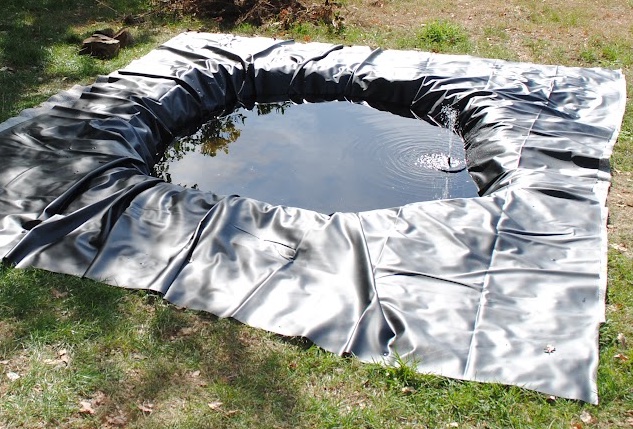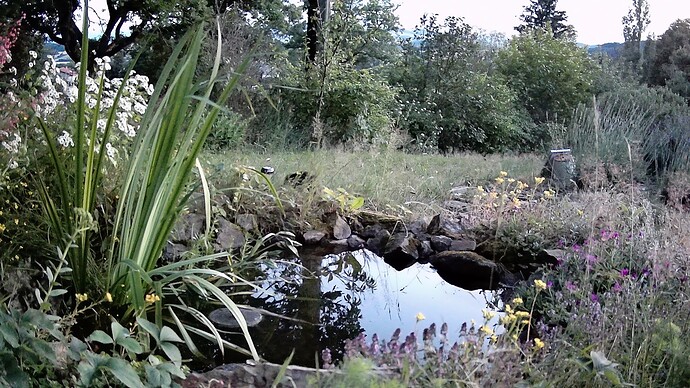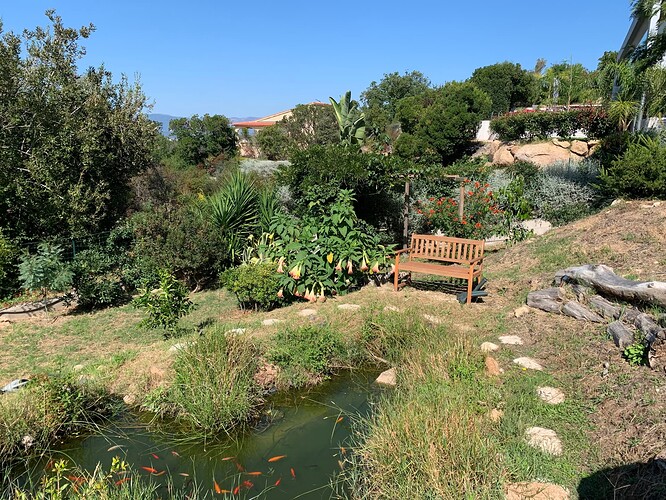I would be grateful for any advice on creating a small pond for wildlife. I don’t want fish in it but would welcome frogs, toads and newts, etc. I have done a small amount of background reading about the basics of making a pond. I want to avoid using a plastic liner and was wondering whether clay would be suitable? Where I live (in the Manche) there is a lot of “argile” (ie clay) available - it used to be an important building materia. I’m far from sure clay would be a suitable lining material, though. I think I read that creating a pond near to houses needs permission but mine would only be of a few square metres. The nearest pond to my planned one is 250 metres away. Would my little one be naturally colonised by the local frogs, etc? As you can probably tell, I am a “débutant intégral” on this subject so any advice will be much appreciated.
Clive
Look at puddled clay ponds, that might be what you are seeking
I confess I used a plastic liner to create a frog and toad friendly pond in our fields, using the helpful guidance from Froglife a UK charity. The frogs and toads seemed appreciative!
There is a reason people use pond liners. Clay is a nightmare unless you know what your doing.
Liners are very simple and you have to work hard to puncture them and they last a long time.
Small ponds I’m sure don’t need a DP
I’ve always used a butyl liner before but I gather there is now a (cheaper) better new alternative. It’s certainly easier than clay and you can generally stand in the pond if you need to without damaging the bottom!
My tips on making a small pond are
-
If you are using a liner put something underneath it to pretect it from sharp stones - any sort of padding or a layer of sand.
-
Ponds appear to shrink, visually, when you make them so make it significantly bigger than you think you want.
-
Have at least one sloping edge so that the pond inhabitants (and creatures that fall it) can get out.
I have loads of other suggestions based on what I’ve done before but don’t want to assume that you don’t already know lots about it ![]()
That is very true, and I’ve never been able to understand why…
Angela makes a very important point…
A plastic pond liner was used for ours for a number of reasons - we have tunnelling “rats taupier”, and moles, and didn’t relish the thought of them digging through a clay/earth lining that would have given way unexpectedly, releasing water and contents into any number of subterranean galleries. I don’t have much sympathy for the rats taupier or the moles, but I would have been somewhat annoyed to watch all the fish get sucked down one of their tunnels.
We put a woollen non-woven fabric intermediate layer between the earth and the pond liner - this is said to prevent the little blighters from getting through the liner above, and also protects the liner from weighty objects laid directly on top - so far it has held out rather well.
We used granite, of which we have lots, both as smallish stones for the bottom, and larger ones for the facing, which we laid on the liner around the edge (no punctures).
All of the planting around the was done by my wife, using what we already had growing wild in other parts of the garden - feverfew, hoekera, honesty, wild strawberries, snow-in-summer, wild thyme (short variety). Then we went to the garden center and bought 3 water plants - a water mint, a flag iris, and some other thing that looks like a short-bladed tiger grass. All of these plants have taken really well, the flag iris being the most prominent, and having flowered this year. In fact, I have to cut it back this year, as it is outgrowing its allotted space.
We also put a few shibunkin goldfish in - due to the small volume of the pond and the limited food supply, they have remained relatively small, which is quite handy. We feed them occasionally, but mostly they feed on what they can find in the pond. Our pond water is very green, with significant algal development. We top it up with rain water only (full or mosquito larvae) from the rainwater vats. We have a solar powered pump to push the water around a bit and oxygenate it more than the water plants can do.
In the 3 years since we put it in, we have toads (every year), frogs (occasional visitors) , grass snakes, at least 3 species of dragonfly, other bottom crawlers, bees and wasps come to drink, and a whole host of birds, along with hedghogs and the occasional raccoon. All in all, not too bad for an afternoon’s work.

Still water - mosquitoes?
Fish food
3 ponds, no mozzies. No idea why, perhaps they just don’t like our neighbourhood .
The first, just outside the front of our house is plastic lined and does have a leak but it is a long time since the level rose to leak through it due to the drought. I have fed 3 rooves via a water butt into it.
The 2nd is really stagnant and filling up with debris (branches, leaves etc), but it is natural and, no mozzies. Once upon a time that was fed by a stream, the overflow from the larger swimming pond up above in the trees. A waterfall in those days fed the bottom pond.
The top pond is the large one for swimming in and is home to a large variety of wildlife, apart from me. Frogs, toads, newts and of course Hissing Sid, my small couleuvre. In fact there are 2 adults and young ones in Spring too. None bother me and in fact swim away to their nest nearby whenever I am emersed.
The bottom ponds are plastic lined over the rocks but the top one, because I knew it was for swimming had first a layer of sand, then of something like carpet underlay before the final layer, rubber. There are no leaks and, an important thing to remember, the shady trees reduce any evaporation to almost nothing. Even in the drought it has had no more than 10 cms below max level.
Had no idea that permission might be needed and in 20 odd years have never had a query. ![]()
Lucky you - and us! But it’s not simply a matter of how far south you are…
We live next to the Lot, but don’t have mosquitos presumably because the river is moving water, OTOH we have South African friends in the Gard, on virtually the same latitude whose house fronts onto a very architecturally fine c18th neoclassical laundrette - une temple de lavage- that has pools of green stagnant water at each corner and in summer our friends and their guest sleep under mosquito nets.
The mosquitoes already had a significant foothold, the rainwater vats have non-sealing covers, some are open, and we already had two old cow drinking water troughs which fill with rain water and mosquitoes. The climate here is quite harsh, so mosquitos only really proliferate when it is warm and humid, which fortunately isn’t usually for very long - but the fish love mosquito larvae !
In an earlier discussion on this sort of topic, someone (sorry, can’t remember who it was) had a goldfish? in her water butt for years and it made short work of mosquito larvae.
It was Bettina.
We have a pond in our garden which we installed four years ago when the house was ready. It’s around 5 m long and one to three wide. We also used a liner on top of a “bidine” (plant proof lining). We have around 50 fish (original and descendants of the first 16 settlers) and four or five frogs as permanent residents and several visiting dragonflies. The frogs just appeared, they probably came from a “basin de retention” just below our garden, about ten metres away. Just noticed some frogspawn in the artificial stream feeding the pond today so hopefully there’ll be more frogs soon. It’s a pleasure sitting and watching the pond life, especially in the spring. Good luck with the pond!
I love this thread! We are also hoping to get a pond in to encourage mossie eaters!!!
I love the idea of a pond… we have a smallish raised corner bed at the far side of a terrace and I reckon that, with the earth removed and a liner placed therein… it would make a nice water feature perhaps with miniature waterlilies… or am I getting too carried away…
does anyone know what one has to do so that the dreaded Tiger Mozzies etc don’t use it as a maternity home… ![]()
at the moment I’m carefully emptying the birdbaths every day, as we’ve been advised to do…
Stick a couple of fish in, they should eat the larvae ![]()

